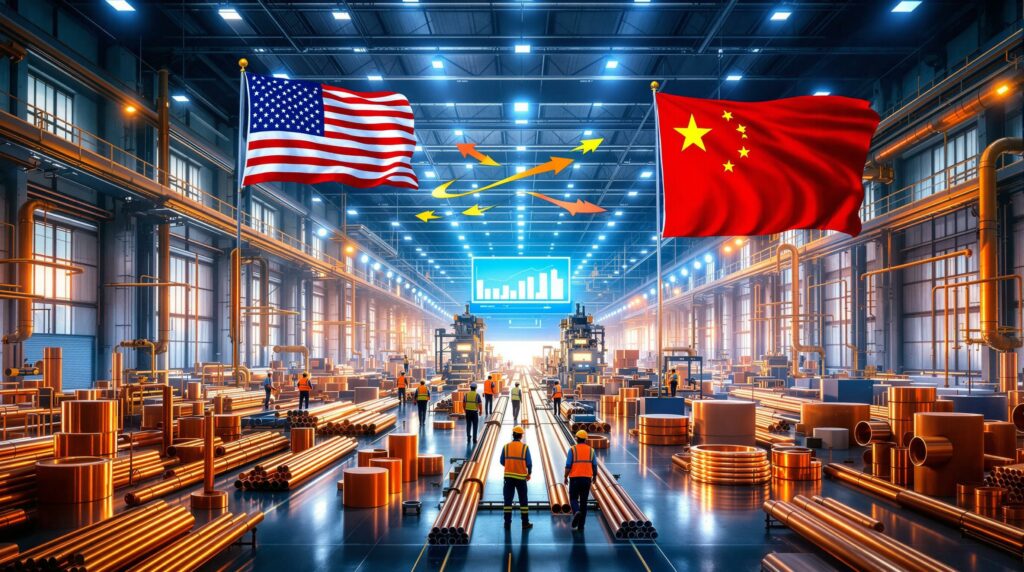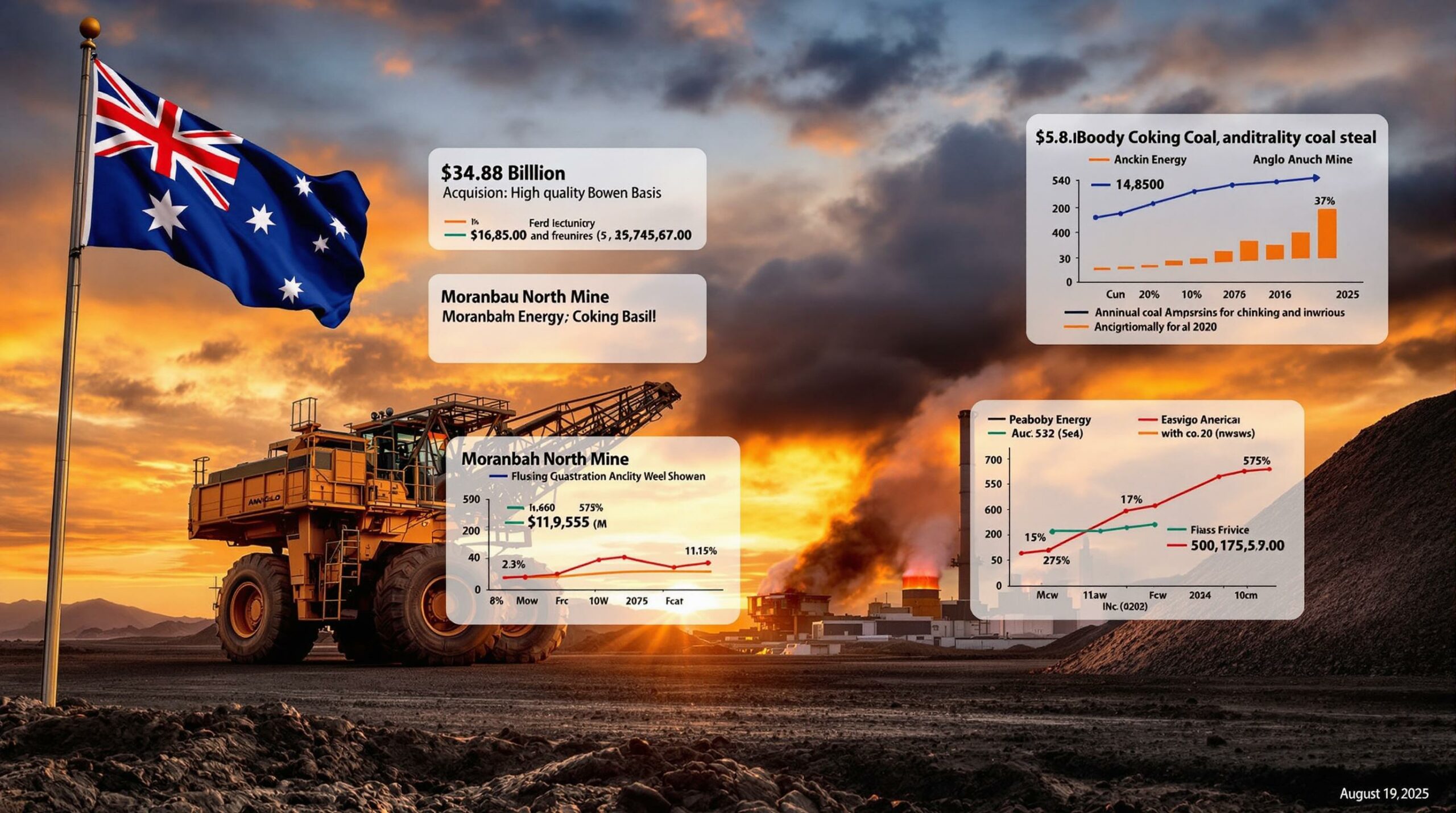Understanding the Impact of US Tariffs on Global Copper Markets
The global copper industry has been thrown into a state of flux following the announcement of substantial tariffs by the Trump administration. In a significant policy shift, a 50% duty has been imposed on semi-finished copper imports, affecting more than $15 billion worth of imports based on the previous year's figures. This dramatic change is reshaping trade flows and creating unexpected winners and losers across the copper manufacturing landscape.
According to analysis from Citic Securities Co., the United States imported approximately 600,000 tons of semi-finished copper last year, accounting for nearly one-third of the country's total copper demand. This high level of import dependency makes the Trump tariffs impact particularly profound for both domestic consumers and international suppliers.
The New Tariff Landscape for Copper
The White House has not only implemented immediate tariffs but has also ordered officials to develop plans within 90 days to potentially extend these duties to additional copper-intensive products. This timeline creates urgency for manufacturers to reassess their supply chains and strategic positions in the US market.
The copper tariffs represent part of a broader protectionist trade strategy aimed at revitalizing domestic US manufacturing and reducing dependency on foreign imports. However, the immediate effect has been market disruption and a rapid realignment of global copper supply chains.
For companies with existing US manufacturing facilities, the tariffs create a competitive advantage through favorable pricing compared to imported alternatives. Conversely, manufacturers relying solely on exports to the US market now face significantly higher costs to maintain their customer base.
The "America First" Strategy and Its Global Ripple Effects
The strategic objectives behind the copper tariff implementation extend beyond simple revenue generation. These measures aim to encourage greater domestic production capacity and investment in US-based manufacturing facilities. The policy operates on the principle that raising the cost of imports will make domestic production more economically viable.
However, the tariffs have created a complex web of unintended consequences. Rather than exclusively benefiting US manufacturers, they have created substantial opportunities for certain international players who previously invested in US production capacity. This highlights how global trade policies can produce outcomes that diverge from their stated intentions.
The ripple effects extend throughout global supply chains, as manufacturers reconsider their copper investment strategies. Market analysts note that this realignment process will likely continue for several quarters as companies adapt to the new trade reality.
Why Is Zhejiang Hailiang Emerging as a Surprising Winner?
Among the most striking outcomes of the new tariff regime is the emergence of Zhejiang Hailiang Co. as a major beneficiary. This Chinese manufacturer of copper tubes for automotive, air conditioning, and plumbing applications has seen its stock jump nearly 20% since the tariff announcement, significantly outperforming both other Chinese copper producers and the broader CSI 300 Index.
What separates Hailiang from many of its competitors is its strategic foresight in establishing manufacturing capabilities within the United States. This positioning has transformed a potential threat into a significant opportunity for the company.
Hailiang's Strategic US Manufacturing Presence
Hailiang operates a production facility in Houston, Texas, with a current annual capacity of 30,000 tons. According to the company's 2020 statement, there are plans to expand this capacity to 100,000 tons, representing a substantial increase in its US manufacturing footprint.
This US-based production capacity now represents a critical strategic asset, allowing the company to serve American customers without the burden of the newly imposed tariffs. With a total global manufacturing capacity of approximately 1.5 million tons annually, Hailiang has positioned itself as a significant player in both domestic Chinese and international markets.
Despite this advantageous positioning, Hailiang's Houston operation has faced challenges, recording a net loss of 35 million yuan (approximately $4.9 million) in 2024. This reflects the broader pressures on the company, which saw its companywide net income drop by 37% to 703 million yuan during the same period.
International Diversification Strategy Paying Dividends
Hailiang's global manufacturing network extends beyond China and the United States to include production bases in Indonesia and Morocco. This international diversification strategy has proven prescient, serving as an effective hedge against both Chinese economic slowdown and increasing trade tensions between China and Western markets.
According to analysis from Citic Securities Co., Hailiang's US factory is now expected to deliver "exceptional profits" as the tariffs make imported competitors' products significantly more expensive. This dramatic reversal of fortune illustrates how quickly trade policy can transform a struggling foreign operation into a strategic advantage.
The company's forward-looking approach to geographical diversification stands in stark contrast to competitors who maintained a China-centric manufacturing strategy. While those companies now face substantial barriers to the US market, Hailiang can continue serving American customers through local production.
Hailiang's potential acquisition of an undisclosed stake in Golden Dragon Precise Copper Tube Group, which operates a plant in Pine Hill, Alabama, suggests the company is looking to further strengthen its US manufacturing presence in response to the changing trade environment.
How Are Markets Responding to the Copper Tariff Situation?
The market response to the copper tariff situation has been marked by significant volatility and selective investor enthusiasm. Companies with established US manufacturing capabilities have seen their stock prices surge, while those dependent on exports to the American market have experienced downward pressure.
Investor Sentiment and Stock Performance
Hailiang's stock performance exemplifies the market's differentiated response, with shares rising nearly 20% following the tariff announcement. This sharp increase stands in contrast to both the broader Chinese market and other copper producers without significant US production capacity.
The CSI 300 Index, a benchmark for Chinese stocks, actually declined slightly during the same period, highlighting how Hailiang's unique positioning has attracted investor attention. Market analysts point to the premium pricing now available for locally-manufactured copper products as the primary driver behind this optimism.
Investment banks and securities firms have begun reassessing the entire copper manufacturing sector in light of these tariffs. Citic Securities Co.'s analysis suggesting "exceptional profits" for Hailiang's US operations reflects a broader reassessment of companies with American manufacturing exposure.
The proposed acquisition of a stake in Golden Dragon Precise Copper Tube Group signals that investors anticipate further industry consolidation as companies seek to secure or expand their US manufacturing presence. This reflects a strategic pivot toward acquisitions rather than greenfield expansion as a means of rapidly responding to the changed trade environment.
Comparative Market Advantages
The tariff implementation creates a significant pricing advantage for companies manufacturing copper products within the United States. With imported alternatives facing a 50% duty, domestic producers can potentially capture premium pricing while still remaining competitive against higher-priced imports.
This advantage must be balanced against the typically higher labour and material costs associated with US manufacturing. However, the substantial tariff more than offsets these higher operational expenses, creating a favorable economic equation for local production.
Companies with existing US manufacturing capacity enjoy a significant head start in this new environment. The time required to establish new production facilities means that current US-based manufacturers will likely benefit from reduced competition for several years as competitors attempt to establish their own American operations.
For Hailiang specifically, the expenses associated with expanding its Houston facility represent a short-term burden but a long-term strategic advantage. With the tariff landscape likely to persist, the return on this investment could substantially exceed previous projections.
What's the Future Outlook for Global Copper Manufacturing?
The implementation of substantial copper tariffs signals a potential long-term shift in global manufacturing strategies. Companies across the copper value chain are reassessing their geographical footprint and market focus in response to this new trade reality.
Potential Industry Realignment
Protectionist trade policies, if sustained, could drive a significant realignment of the copper manufacturing industry. The historical advantages of centralized production in low-cost regions may be offset by the need for regional manufacturing presence to avoid tariff barriers.
Companies with existing US manufacturing facilities have gained an immediate competitive advantage that could persist for several years. The capital-intensive nature of copper manufacturing creates substantial barriers to entry, meaning that established players can potentially enjoy an extended period of favorable competitive positioning.
For purely export-based manufacturers, the new tariffs present an existential challenge to their US market presence. These companies face difficult decisions about whether to accept reduced market share and profitability, establish US production facilities, or redirect their focus to other international markets.
The White House directive to develop plans for expanding tariffs to additional copper-intensive products within 90 days creates further uncertainty. This timeline suggests that the full scope of the new tariff regime remains undefined, complicating long-term strategic planning for manufacturers across the copper value chain.
Strategic Considerations for Copper Manufacturers
Geographical diversification has emerged as a critical strategic priority for copper manufacturers. Companies with production facilities limited to a single country or region face increased vulnerability to trade tensions and policy shifts.
The balance between production costs and market access considerations has shifted dramatically. While centralized production in low-cost regions previously optimized profitability, the new tariff environment potentially favors a more distributed manufacturing footprint despite higher operating costs.
For companies with available capital, acquisition opportunities may present themselves as smaller manufacturers struggle to adapt to the new trade landscape. Strategic consolidation could allow larger players to rapidly expand their US manufacturing presence without facing the delays associated with greenfield development.
Production capacity planning amid uncertain trade policies presents a significant challenge. Manufacturers must balance the risk of overinvestment against the potential opportunity cost of insufficient capacity if tariffs remain in place long-term.
How Are Other Companies Responding to the Copper Tariff Situation?
The copper manufacturing industry's response to the tariff situation varies significantly based on companies' existing US manufacturing presence, financial resources, and strategic priorities.
Competitive Landscape Shifts
Golden Dragon Precise Copper Tube Group, with its plant in Pine Hill, Alabama, represents another potential beneficiary of the new tariff environment. Like Hailiang, the company's existing US manufacturing footprint provides a significant competitive advantage in serving the American market.
Copper product manufacturers are employing diverse strategies to navigate the changed trade landscape. Some are accelerating previously planned US investments, while others are exploring joint ventures or acquisitions to rapidly establish American production capacity.
US-based copper miners and processors potentially stand to benefit from surging copper demand if manufacturing operations shift to American soil. This could create positive spillover effects throughout the domestic copper value chain, from mining to refining to finished product manufacturing.
The full competitive landscape remains in flux, with companies at various stages of strategic reassessment. Those with strong balance sheets and operational flexibility appear best positioned to adapt to the changed environment, while highly leveraged firms with fixed manufacturing footprints face greater challenges.
Investment and Expansion Decisions
Capital allocation trends following tariff implementation reflect a significant shift toward US-based manufacturing investment. Companies with existing American facilities are prioritizing expansion projects, while those without US presence are exploring acquisition opportunities as an expedited entry strategy.
The timeline considerations for new manufacturing capacity present a significant challenge. With copper production facilities typically requiring 18-36 months from planning to full operation, companies face a substantial lag between investment decisions and operational capability.
Risk assessment for cross-border copper industry investments has become increasingly complex. The potential for retaliatory tariffs, further trade policy changes, and political uncertainty complicates the return calculations for major capital investments.
Many manufacturers are adopting a phased approach to expansion, preserving flexibility while market conditions stabilize. This cautious strategy allows companies to adjust their investment pace as the full implications of the tariff regime become clearer over time.
FAQ: Trump's Copper Tariffs and Global Manufacturing
What specific copper products are covered by the new tariffs?
The 50% duty applies to semi-finished copper imports, which encompasses a broad range of intermediate products used in manufacturing. The White House has directed officials to develop plans within 90 days for potentially extending these tariffs to additional copper-intensive goods.
Semi-finished copper products typically include copper tubes, pipes, wire, sheets, and plates that serve as inputs for manufacturing across multiple industries including automotive, construction, electronics, and consumer goods. The precise categorization follows the Harmonized Tariff Schedule classifications.
Raw materials such as copper ore and concentrates appear to remain outside the current tariff regime, though this could change as the policy evolves. The distinction between raw materials and finished products creates complex considerations for vertically integrated manufacturers.
Companies utilizing copper in their production processes should consult with trade experts to determine the specific tariff implications for their supply chains, as the classifications can be highly technical and subject to interpretation.
How might these tariffs affect consumer prices for copper-containing products?
The price transmission mechanisms through supply chains suggest that consumers will likely see increased prices for copper-containing products, though the timing and magnitude will vary by sector. Products with higher copper content percentages will naturally experience more significant price effects.
Home appliances, air conditioning systems, and plumbing supplies represent product categories likely to see more immediate price increases. The essential nature of copper in these applications limits manufacturers' ability to substitute alternative materials.
The timeline for consumer market impacts will vary, with existing inventory providing some buffer against immediate price increases. However, as manufacturers deplete pre-tariff inventory and replace it with higher-cost materials, price adjustments will become increasingly visible to end consumers.
Several factors could potentially offset the full impact of tariffs on consumer prices. These include absorption of costs within manufacturer margins, efficiency improvements in production processes, and potential moderation of base copper price predictions due to reduced global demand.
Are other countries implementing retaliatory measures against US copper exports?
While specific retaliatory measures directly targeting US copper exports have not been widely reported, historical patterns in trade disputes suggest the potential for escalation. Trading partners affected by US tariffs typically respond with targeted countermeasures on American exports.
The potential for escalating trade tensions creates additional uncertainty for global copper markets. If major copper-consuming nations implement retaliatory tariffs, this could further disrupt established trade flows and create additional market volatility.
Global copper production forecast benchmarks may experience increased volatility as markets adjust to the new trade reality. The redistribution of trade flows typically creates temporary supply-demand imbalances in regional markets until a new equilibrium is established.
Companies operating in the copper sector should monitor diplomatic developments closely, as statements from affected trading partners may provide early indicators of potential retaliatory measures before formal implementation.
How are US domestic copper manufacturers responding to the tariff protection?
Capacity expansion considerations are likely at the forefront for US domestic copper manufacturers. The tariff protection improves the economic case for investing in additional American production capacity, potentially reversing the long-term trend of manufacturing migration offshore.
Employment trends in US copper manufacturing could see positive momentum if domestic production expands. However, the capital-intensive nature of modern copper manufacturing means that production increases may not translate proportionally to job creation.
Technological investment to improve competitiveness represents another likely response from domestic manufacturers. With the tariff providing breathing room against low-cost imports, US producers have an opportunity to invest in automation and process improvements that enhance long-term competitiveness.
Industry associations and individual companies are likely engaged in lobbying efforts regarding the scope and duration of trade policy. Domestic manufacturers generally favor policies that provide predictable long-term protection rather than temporary measures that complicate investment planning.
Chinese Copper Makers and Trump's Tariffs Through Strategic Positioning
The implementation of Trump's tariffs on copper products has created a complex competitive landscape that defies simple categorization. Rather than uniformly benefiting US manufacturers or harming Chinese producers, the policy has created a nuanced environment where strategic positioning determines winners and losers.
Chinese copper makers with foresight to establish US manufacturing operations, like Zhejiang Hailiang, have transformed potential adversity into competitive advantage. Their investments in American production capacity, once struggling financially, now represent valuable strategic assets in the changed trade environment.
The contrasting fortunes of different Chinese copper manufacturers illustrate how geographical diversification has become essential in navigating an increasingly fragmented global trade landscape. Companies that maintained a China-centric production strategy now face significant barriers to the US market, while those with distributed manufacturing networks can continue serving American customers through local production.
For the broader copper industry, Trump's tariffs have accelerated the trend toward regionalized manufacturing to circumvent trade barriers. This shift challenges the decades-long movement toward globalized, centralized production and suggests a future where geographical flexibility may prove more valuable than pure cost efficiency.
As the industry adapts to this new reality, both Chinese and American copper manufacturers face critical strategic decisions that will shape their competitive positioning for years to come. The winners in this evolving landscape will likely be those who can most effectively balance regional production presence with operational efficiency while remaining flexible enough to adapt to further policy changes.
Want to Stay Ahead of Major Mineral Discoveries?
Discover why major mineral discoveries can lead to significant market returns by exploring Discovery Alert's dedicated discoveries page, which showcases how the proprietary Discovery IQ model identifies high-potential ASX announcements before the broader market reacts.




